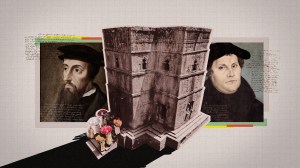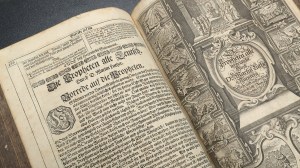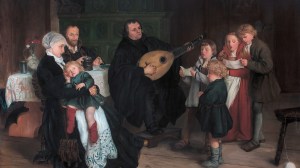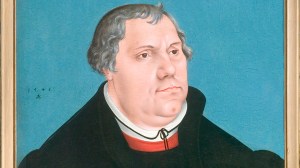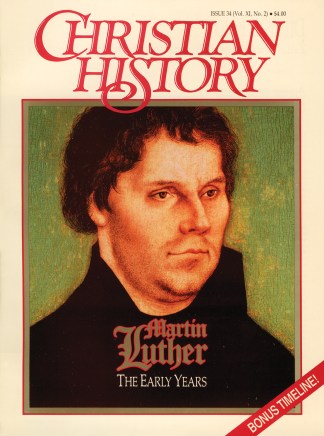In this series

Martin Luther became a legend in his own time. Soon after 1517, as the 95 Theses made him famous, stories and pictures began to paint him larger than life.
One early woodcut portrayed Luther as a young monk holding an open Bible, while rays of light stream from a halo surrounding his head.
After the Diet of Worms in 1521, a popular pamphlet retold the story of Luther’s appearance before Emperor Charles V—with characters and scenes from the Passion of Christ.
While Luther’s followers were eager to make him a saint, his opponents were just as eager to discredit him. One of his earliest biographers, the Catholic critic John Cochlaeus, suggested that Luther seemed peculiar to his monastic brothers because he once suffered a fit during mass. When Luther heard the Gospel lesson (Mark 9:14–29) about the boy with the deaf and dumb spirit cast out by Jesus, he allegedly fell to the floor crying, “It is not me, not me!” This legend has continued to fuel suspicion that Luther suffered from a mental disorder; psychoanalyst Erik Erikson made it the subject of an entire chapter in his popular book Young Man Luther (1958).
Most misconceptions about Luther, however, arose harmlessly and only gradually. Like all myths, they contain a kernel of truth. Here are five often told experiences from Luther’s life that need some clarification.
1. Thunderstorm “Conversion”
A Damascus-road experience?
After Luther finished his Master of Arts degree at the University of Erfurt, he embarked on the study of law. Then, in the summer of 1505, after a visit to his parents’ home, Luther returned to Erfurt. Frightened by a thunderstorm near Stotternheim, he cried out: “Help me, St. Anna! l will become a monk.”
This sudden decision made on the road in a flash of lightning reminded contemporaries of the conversion of St. Paul on the road to Damascus. The comparison remained popular well into the nineteenth century.
More than likely, Luther was indeed frightened by a storm near Stotternheim. By his own account he did vow to St. Anna, the popular patron saint of miners, that he would become a monk.
Were the storm and Luther’s vow, however, akin to Paul’s conversion? Not necessarily. Luther was certainly not converted in the sense that a formerly indifferent young man suddenly became serious about religion.
Furthermore, Luther regretted having made the vow. He not only adopted the monastic life but also, unlike Paul with Christianity, left it again.
Still, the experience did have marks of a conversion. When Luther entered the monastery, he went from living in the world to living in the cloister—a change that for centuries had been described as “conversion.” Like a new convert, he took his new life seriously. “If ever a monk could have reached heaven through monkery,” he asserted, “then it was I.”
2. “Tower Experience”
Instant discovery?
According to older biographies, Luther discovered the gospel all at once while reading Paul’s Epistle to the Romans in the tower of the Augustinian cloister. That notion was based on direct and indirect sources supplied by the reformer himself.
In the direct source, a flashback written the year before his death, Luther described how a new understanding of God’s righteousness finally came to him after he had meditated day and night on Romans 1:17–18.
The indirect source is Luther’s Table Talk, a compilation (by students and associates) of Luther’s observations at meals during his later years. In the Table Talk, Luther located his discovery both in the tower and in the cl. of the monastery.
Some scholars, especially those favoring a psychoanalytical interpretation, read cl. as cloaca, “toilet,” and reconstructed a scene that connected Luther’s discovery with both physical and emotional release.
Recent research, however, has generally abandoned the image of Luther’s theological discovery as a sudden, momentary experience. All the sources are flashbacks. It is likely that the discovery came as the culmination of a long, painstaking attempt to understand Paul’s saying that the righteousness of God was revealed in the gospel (Romans 1:17). At the end of his flashback, Luther emphasized how hard he had worked at understanding Scripture, not how quickly he had arrived at that understanding.
Luther scholars still are not united on an exact date for Luther’s discovery. But most agree that between 1515 and 1518, as he diligently studied and lectured on the Bible in Wittenberg, Luther arrived at a new, positive understanding of righteousness as a gift of God received in faith.
3. Posting 95 Theses
Did he nail them to the Castle Church door?
Countless Protestant bulletin covers for Reformation Sunday have pictured Luther as a rebellious monk nailing the 95 Theses to the door of the Castle Church in Wittenberg on October 31, 1517. Luther himself never reported having engaged in such an act of protest.
The depiction of his posting the theses stems from his younger colleague, Philipp Melanchthon, who was not in Wittenberg in 1517, and who did not record the incident until after Luther’s death. Nevertheless, the story became a standard part of Luther lore and Luther biographies until recently.
The posting of the theses was called into question by Catholic historian Erwin Iserloh in 1961. He pointed out that the debate to which the theses were an invitation never took place in Wittenberg. Further, in order to provoke discussion of papal indulgences, Luther sent the theses to his superiors in the church and to other scholars around Germany. According to Iserloh, the theses were not nailed; they were mailed.
This challenge by a Catholic historian at first elicited protests from Protestant scholars. They rightly pointed out that in other ways Luther did attack abuses in the indulgence trade. Attempts were made to prove that Luther had indeed nailed the theses to the church door, even if they were meant only to announce a debate. Gradually, however, Iserloh’s view has gained wider acceptance and softened the picture of how the Reformation began.
4. “Here I Stand!”
Did he really say that?
In April 1521, Luther appeared before Emperor Charles V to defend what he had taught and written. At the end of his speech, the story goes, he spoke the famous words, “Here I stand; I can do no other. God help me.”
The earliest printed version of Luther’s address added these words, which were not recorded on the spot. It’s possible they are genuine, but for almost a half century now, most scholars have believed they were probably not spoken by Luther.
A second misunderstanding arises when the words “Here I stand” are quoted as evidence of Luther’s modern stand against the medieval powers of church and empire. Luther’s speech was not a defiant, solitary protest, but a calm, reasoned account of why he had written the books piled on the table before him and why he could not recant their content.
Luther asserted that his conscience was captive to the Word of God and that he could not go against conscience. This was not, however, a modern plea for the supremacy of the individual conscience or for religious freedom. Though already excommunicated by Rome, Luther saw himself as a sworn teacher of Scripture who must advocate the right of all Christians to hear and live by the gospel.
5. Hurling An Inkwell at the Devil
How did the spot get on the wall?
Whatever he might say at Worms, Luther had been guaranteed safe conduct back to Wittenberg. Because, however, Charles V declared Luther an outlaw, his prince, the Elector Frederick, had Luther kidnapped and placed in hiding at the Wartburg Castle.
Later stories of Luther’s ten-month stay at the Wartburg frequently told of his battle with the Devil. The Devil constantly disturbed his work—as a fly buzzing around his head, or as a large, black dog in Luther’s bed, or by making a racket to keep Luther awake. The most famous story told how Luther once threw an inkwell at the Devil. Guides showed enthralled visitors to the Wartburg the spot behind the stove where the inkwell had hit the wall.
The first evidence of a story involving an inkwell dates to the end of the sixteenth century. In that version, a former Wittenberg student claimed to have heard that while Luther was at the Wartburg, the Devil, dressed as a monk, threw an inkwell at the reformer.
In 1650 the first book to refer to an inkspot on the wall appeared, and thereafter the story told how Luther threw the inkwell at the Devil. Gradually, an inkspot appeared on the walls of other buildings where Luther had lived, and the story became a widely-known legend.
Although definitely a fabrication, this legend points to an important truth about Luther. He was a deeply devout man of his age who believed strongly in the existence of the Devil. The Christian life was a constant battle against the Devil, who was behind every evil act and disaster. Christians needed to pray every day, coached Luther in his Catechism, that God would forgive their sins and strengthen their faith so they could survive this struggle. The reformer spoke from experience; even though he trusted that God would finally defeat the Devil, he was also subject to attacks of doubt and spiritual despair. If Luther did once launch an inkwell at his most dreaded adversary, he would not have been acting out of character.
Dr. Scott A. Hendrix, a family therapist, was formerly professor of Reformation history at Philadelphia Lutheran seminary. He is author of Luther and the Papacy: Stages in a Reformation Conflict (Fortress, 1981).
Copyright © 1992 by the author or Christianity Today/Christian History magazine.Click here for reprint information on Christian History.


